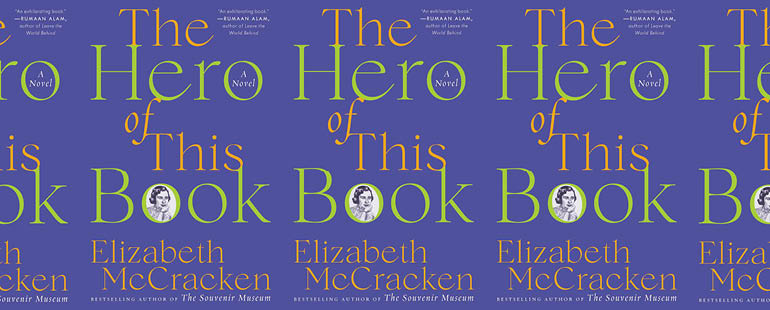Disappearing Bodies in Elizabeth McCracken’s The Hero of This Book

The Hero of This Book
Elizabeth McCracken
Ecco | October 4, 2022
Elizabeth McCracken’s novel The Hero of This Book marks a moment in time, summer 2019, “the summer before the world stopped.” The book is occasioned by a solo trip its narrator takes to London from her home in the United States, ten months after the death of her mother, Natalie Jacobson McCracken. We learn the mother’s name—which resembles the author’s—in a footnote near the end of the book, which jettisons conventions of genre and humorously combines the cadences of memoir with claims of fictionality. Though purportedly a graduate of the Iowa Writers’ Workshop in fiction and the author of numerous publications in that genre, McCracken’s narrator resists being called a “novelist” now writing a “memoir.” The stories we tell while grieving tend to be too complicated and contradictory to classify anyway. It is enough, McCracken’s book argues, just to be a person with memories.
McCracken makes clear from the onset that her portraits of mother and daughter are inextricably linked. Natalie, who at one point was able to travel with the narrator, grew up “disabled and Jewish in small-town Iowa.” The narrator, who is now herself middle-aged, recalls, with tender detail, her mother’s cerebral palsy, her size-four feet, and her canes with their right-angled Fritz handles. She observes London, its people, and its infrastructure through her mother’s eyes and, in many ways, through her mother’s body. Walking therefore becomes an important motif in the book.
Although several flashbacks take place in Natalie and her late husband’s house, the narrator McCracken has crafted is very much a figure of a flâneur: out in the city, she has no plans for the day and nothing on her but a burner phone. Exploring London on foot, mingling with the sights and sounds of the city, the narrator recalls, in a pinball fashion, vivid scenes from her past. During the day in which this novel takes place, Natalie seems to accompany her, appearing in spirit at familiar landmarks and on the paths the two once took. At the sight of St. Paul’s Cathedral, for instance, the narrator recalls being in London in 2016 with her mother, at the time nearly eighty-two. During that trip, the narrator climbed to the top of St. Paul’s by herself. This time around, the narrator recognizes that she has since “grown stouter and gammy of knee,” and she, too, passes on the opportunity to see the view.
London is described, in a particularly brilliant passage, as a coat that covers the body. “Who cares about the shape beneath,” McCracken writes, “when the shape is changed by the wind as you walk, by each turn of the weather.” And yet, the body is ever present, asserting itself as a gammy knee, blurry eyesight, all throughout the book.
“When you become a flaneur or a flaneuse, you are supposed to disappear from the narrative,” McCracken writes. “Same thing when you are a mother.” Her novel shows that this disappearing act is harder than it sounds, particularly for people with bodies for whom public spaces are not designed to be accessible. For example, in one scene, the narrator takes a glass elevator that delivers her diagonally up a flight of stairs on the banks of the Thames. As the elevator slowly ascends, a mother and child point at her—or, rather, they point at the elevator. “I was invisible inside it,” the narrator notes.
Contained in this moment, we sense, are all the unsolicited comments Natalie and the narrator used to receive when they walked in public together—“Tell her to watch her step,” for example, or, “What happened to you, sweetheart?” To be visible or invisible in the public eye, the novel implies, is not a choice one makes. However, one can decide whether to disappear or to, instead, walk into the frame of a tourist’s photograph—“It was one of the wonders of the modern age, the ability to not give a fuck about ruining other people’s photographs”—or to claim a seat, as our narrator does, on a bench in front of the Rothkos at Tate Modern, in spite of the man using the room as his personal phone booth.
If we negate the body in our writing—and in our memories—the novel argues, we risk representing the people we love as nothing more than “sentient, anguished helium balloons.” Fittingly, the disappearance of the human body from certain types of art also irks the narrator. During her visit to Tate Modern, which unfolds the way the rest of her day does—pensively and in great solitude—she confesses that she prefers figurative art to the likes of Rothko’s abstract color-field paintings. She realizes that abstract meditations on death and grief mean just as little to her. Likewise, her memories of Natalie Jacobson McCracken are stored in the body. They come to life not because she scrutinizes them over a writing desk but because she walks.
Readers who delight in forthright and fearless stories of complicated women, told through the eyes of other complicated women, are sure to find joy in McCracken’s new book. Those who have walked with the memory of a loved one will find solace in the narrator’s final revelation—that the hero of the book and the storyteller remain forever connected, as neither will let the other go.


